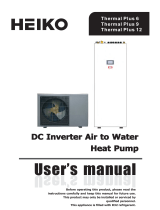LG BSUQ12HYZD Owner's manual
- Category
- Split-system air conditioners
- Type
- Owner's manual
LG BSUQ12HYZD is a high-tech air conditioner with an abundance of features to enhance your comfort and well-being. LG BSUQ12HYZD is equipped with a powerful cooling capacity of 12000 BTU, ensuring effective cooling even on the hottest days, making it ideal for medium-sized rooms. The unit features a 6-step fan speed adjustment, allowing you to customize the airflow intensity based on your preference. The air swing function ensures even distribution of cool air throughout the room, preventing stagnant zones.
Furthermore, LG BSUQ12HYZD boasts a host of health-enhancing features.
LG BSUQ12HYZD is a high-tech air conditioner with an abundance of features to enhance your comfort and well-being. LG BSUQ12HYZD is equipped with a powerful cooling capacity of 12000 BTU, ensuring effective cooling even on the hottest days, making it ideal for medium-sized rooms. The unit features a 6-step fan speed adjustment, allowing you to customize the airflow intensity based on your preference. The air swing function ensures even distribution of cool air throughout the room, preventing stagnant zones.
Furthermore, LG BSUQ12HYZD boasts a host of health-enhancing features.














-
 1
1
-
 2
2
-
 3
3
-
 4
4
-
 5
5
-
 6
6
-
 7
7
-
 8
8
-
 9
9
-
 10
10
-
 11
11
-
 12
12
-
 13
13
-
 14
14
LG BSUQ12HYZD Owner's manual
- Category
- Split-system air conditioners
- Type
- Owner's manual
LG BSUQ12HYZD is a high-tech air conditioner with an abundance of features to enhance your comfort and well-being. LG BSUQ12HYZD is equipped with a powerful cooling capacity of 12000 BTU, ensuring effective cooling even on the hottest days, making it ideal for medium-sized rooms. The unit features a 6-step fan speed adjustment, allowing you to customize the airflow intensity based on your preference. The air swing function ensures even distribution of cool air throughout the room, preventing stagnant zones.
Furthermore, LG BSUQ12HYZD boasts a host of health-enhancing features.
Ask a question and I''ll find the answer in the document
Finding information in a document is now easier with AI
Related papers
Other documents
-
Whirlpool SPIW309A3WF User guide
-
Whirlpool PACHW2900CO Program Chart
-
 Heiko NCSMS00370A00 DC Inverter Air to Water Heat Pump User manual
Heiko NCSMS00370A00 DC Inverter Air to Water Heat Pump User manual
-
Total HYD14KPACWA User manual
-
Dimplex DPRC20ECO-A Portable Air Conditioner User manual
-
Svan SVAN212PBL Owner's manual
-
Svan SVAN291PF Owner's manual
-
Tesla Monoblock TGTP-8MBDA1 User manual
-
Sinclair ASM-12PI User manual
-
 Kaisai KEX-18KTAI User manual
Kaisai KEX-18KTAI User manual















